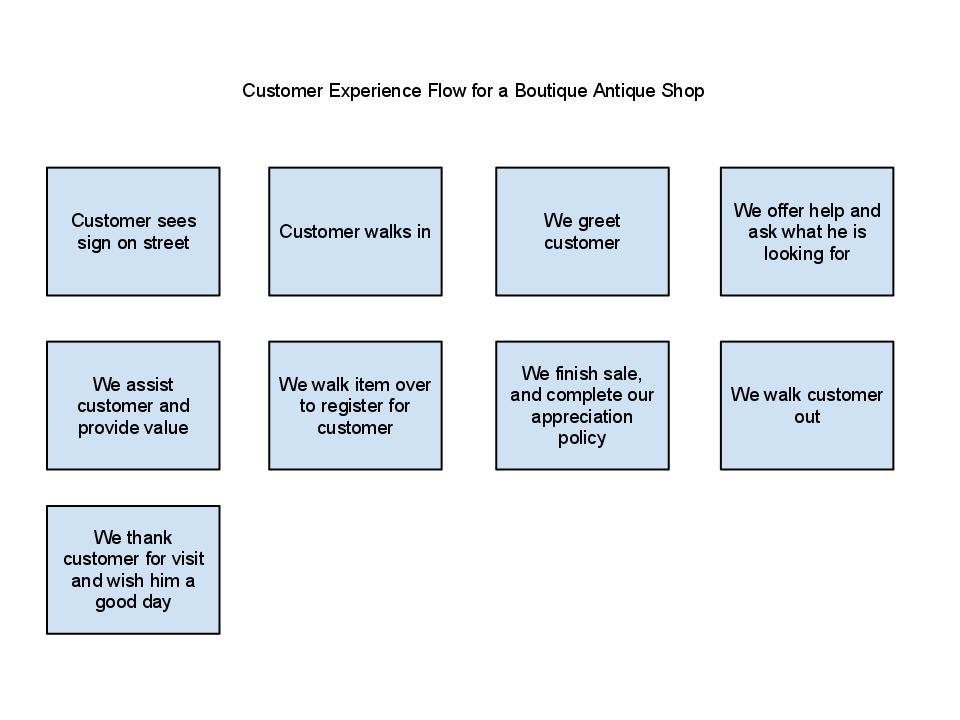SalesVu helps you improve your customer service by making credit card processing really, really easy. Check us out.
As more and more business transactions get both conducted and rated on an increasingly social web, customer service is now more important than ever. In days of yore, a customer’s dissatisfaction usually found an audience of her friends and family. Now, no joke, THOUSANDS of people can hear about a negative experience, and not just hear about, but tweet it, like it, share it, email it—with the click of a button.
TechCrunch recently highlighted startling insights from the Customer Experience Impact 2010 report from RightNow. The most important takeaway: 82% of consumers in the U.S. said they’ve stopped doing business with a company because of a poor customer service experience.
And that’s a real shame, not just in a “let’s be nice to each other” kind of way (though we should of course). It’s a shame because poor customer service has a direct and significant impact on the bottom line, especially when considering customer lifetime value and the power of word-of-mouth marketing.
So what can you do to ensure you don’t suffer the same effects as this or this?
Make amazing customer service a priority of your business. Here’s how.
Be a Customer at Your Own Business (or a Competitor’s)
When was the last time you walked through your business, either for real in the physical world, or as a rehearsal in your mind, from the point of view of your customer? From being unaware of you, to aware, to walking in, to shopping, to buying, to leaving?
This exercise is important because as the business owner, you are so wrapped up in your own concerns, it’s easy to take for granted the experience of your customer on an individual level. The moment you do that, or, if you’re reading this and you realize you’ve never consciously considered that process, you’re in trouble. There are critical blindspots that need attention.
If you own a restaurant, go out to eat at a competitor and take notes. Where do you as a customer feel like your needs are left unmet? Where are your needs not just met, but you are delighted?
If you own a dog walking business, think through and write down the steps someone goes through as they meet you and hire you. How does it start? Where are you? Where are they? What happens?
If you have a salon, book yourself a haircut. Walk in. Where do you sit? Would you like a coffee, tea? Reading material? One salon I went to in Miami provided little netbooks for browsing the web. Later, when I moved out of the city, I deliberately delayed getting a haircut for one month so I could visit that salon when I was back in town.
You want to go through and experience your business as just a regular customer off the street, so you can see where you can blow her mind and delight her.
Articulate what the customer experience is, start to finish, step-by-step.
Here’s an example:

Get Inside Your Customers’ Minds
Once you’ve worn their shoes, it’s time to get inside their minds. Take out a piece of paper or open up a word document and answer the following questions:
- Who is your ideal target customer?
- What is the main benefit that he wants when he chooses your business?
- What’s important to him?
- What is he afraid of (in the context of your business)?
- What is he frustrated by?
- What does he really, actually want?
For example, the main benefit of a salon.
You own a salon. What do you sell?
It’s not haircuts. It’s confidence. Looking great. Standing out.
What are some frustrations your ideal target customer might have?
“I’m tired of stylists who don’t listen to me or understand what I’m trying to say.”
“My hair color constantly fades, or I’m never happy with the way it looks.”
“I can’t recreate the look at home.”
And so forth. Knowing these frustrations, what can you do to immediately stand out from your competition? Provide the solution to these frustrations.
Once you know what your ideal target customer truly wants, you can overdeliver on what he or she wants and win loyal customers for life.
(Finding out what she wants is as simple as asking. Keep your eye out for a post in the future that digs deep into how to do this in a way that makes both you the business owner happy and doesn’t weird out the customer or seem strange.)
So what does your ideal target customer really want when she enters your store or otherwise does business with you?
Identify The Values Your Business Demonstrates
We all have that friend who is consistently late. Or only calls when he needs something. Or nine times out of ten cancels at the last minute. Or doesn’t really listen to you and just talks about himself.
You eventually phase those kinds of people out of your life. And that’s because that person’s behavior demonstrates values that you don’t find appealing. If someone is consistently late, she is saying, “I don’t respect your time,” and one of her values (unconsciously or consciously) is “My time is more important than others’ time.”
Your business is the same way. Each interaction you have with a customer expresses the values of your business.
The key is to 1). know what those values are and 2). translate those values into concrete actions that express those values.
This story about the Ritz Carlton has been passed around quite a bit, because it perfectly captures this idea. It’s interesting because the Ritz is very value-driven. And it finds ways to express those values in concrete actions.
Tony Hsieh is famous because of this .
What values drive your business?
How can you express those values in a concrete way?
Pick What’s Most Important
There are countless little tips online, lists of 50, of 75, of 101 little tips. These range from the obvious — “Smile!” — to the less obvious — “Make sure signing the receipt is NOT the last exchange a customer has with you before leaving your shop.” But all of those tips are meaningless if they aren’t coming from a framework that you truly understand. Or if you just put lipstick on a pig and try the tips out without knowing what your customer actually experiences, what they want, and what values you’re demonstrating as a business.
You are busy. You have financial goals you want to hit. Time and money is precious. So you need to save time and make small, powerful changes.
The next step is to identify just 3 key areas to improve. Why three?
We say three because there are a million things that you could do — and as a result, you do nothing. By focusing on three, you keep it psychologically very do-able.
So what are your three? Perhaps it’s the way you greet your customers. Perhaps its listening. Maybe it’s figuring out a way to turn a mundane step in the process (waiting for your appointment) into a delight (providing a complimentary cup of tea).
Whatever you think, limit yourself to three areas. What are they?
Turn This Advice into Actionable Steps You Can Test Today
Now that you’ve got your three areas, you just need to convert them into concrete behaviors or policies you can implement.
For example, if you want to improve the way you listen to your customers, then that can translate to making sure you maintain eye contact with them, possibly even noting their eye color.
If you want to make your store more welcoming, then set a policy of warmly greeting new customers and welcoming back returning customers.
If you’d like to be a business known for its appreciation of its customers, set up a simple system of including a little token of gratitude in the customer’s shopping bag, perhaps a note, or a chocolate.
By articulating these changes specifically, you ensure you’ll actually stick to it. And then you’ll be on the path to truly delighting your customers.
What 3 concrete changes can you test today?
These are just some considerations and ways to rock customer service. What other suggestions do you have for delighting your customers?
SalesVu helps you improve your customer service by making credit card processing really, really easy. Check us out.



